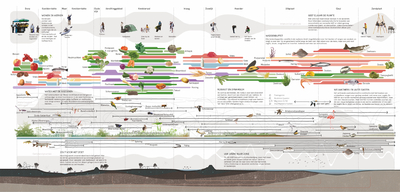×
Waddenkust
Edible Coast
7/9
Moving with the dynamics
Edible Coast
It is only possible to tackle climate change with a flexible attitude. The best approach is to respond to the dynamics and diversity of the landscape. This forms the basis for a new vision: The Edible Wadden Coast.
The variety between fresh and salty, wet and dry, high and low and clayey and sandy of-fers scope for flora, fauna and a varied food landscape. Nature and agriculture no longer contrast with each other. They are being intertwined in a wide, multi-faceted coastal zone. The way in which it is designed anticipates the forthcoming climate changes. It supplies the three northern provinces with sufficient food and a diverse menu all year round.
The variety between fresh and salty, wet and dry, high and low and clayey and sandy of-fers scope for flora, fauna and a varied food landscape. Nature and agriculture no longer contrast with each other. They are being intertwined in a wide, multi-faceted coastal zone. The way in which it is designed anticipates the forthcoming climate changes. It supplies the three northern provinces with sufficient food and a diverse menu all year round.
From production for the world market to circular agriculture
Designing a dynamic food landscape

Eat well plate for the Groningen Wadden Coast
What will we be eating in 2100?
Opportunity for a wide range of products: from potatoes to cockles, from salicornia to mus-tard and from chard to smelt. In 2100, our menu will largely consist of local – sometimes forgotten – crops and catches, as well as new forms of proteins such as algae and insects. Because the climate is getting warmer, we will be able to grow crops which can currently only be found further south.
Opportunity for a wide range of products: from potatoes to cockles, from salicornia to mus-tard and from chard to smelt. In 2100, our menu will largely consist of local – sometimes forgotten – crops and catches, as well as new forms of proteins such as algae and insects. Because the climate is getting warmer, we will be able to grow crops which can currently only be found further south.
Image of the productive salt marsh
Six interventions as a starting point for the Edible Coast
The new salt marsh coast offers opportunities for flood protection as well as food produc-tion, and contributes to the restoration of biodiversity. Silting gives protection against the rising sea level. The division of the salt marsh into plots which are excavated at different times results in a variety of development stages and heights, thereby resulting in a varied topography that breaks up waves and provides a varied food landscape. Salicornia grows on the low-lying parts, young livestock graze on the mid-lying parts and grain and beans grow on the highest salt marsh.
By reconnecting the watercourses from the hinterland with the sea streams, this not only improves the conditions for migratory fish, but new recreational intersections are also cre-ated on the Wadden Dike. These are connected to the villages in the hinterland. The inter-sections form the starting point for Wadden excursions. Fish, shellfish and crustaceans and other products are also brought to the land and sold there. The reintroduction of the sluice gate makes it possible for migratory fish to pass.
In de landbouw van de toekomst worden lokale condities zoveel mogelijk benut en kringlopen gesloten. Akkerbouwers en veetelers kunnen meststoffen en veevoer uitwisselen ten behoeve van de circulariteit van de landbouw. Er komt meer ruimte voor akkerranden, bomenlanen en natuurlijke waterlopen. Een verhoging van de organische stof in de bodem, op de kwelderwallen en de laagtes rond de maren, biedt mogelijkheden om het zoete water langer vast te houden en geleidelijk af te geven aan de omliggende landbouwgronden.
In inland areas susceptible to soil salinization, experiments can be carried out with brack-ish or salty conditions as the new basis for agriculture. They offer opportunities for the de-velopment of new salt-tolerant crops. These bring an entirely new flavour to the area and provide knowledge on the growing of products in delta areas for use all over the world.
The Lauwersmeer is getting its salty dynamics back again. A (faint) tide creates a variable water level, variation in fresh and salt water and an ecological connection with the sea. The vegetation in the area is harvested in different phases. Thanks to an open connection with the Wadden Sea, Zoutkamp can be put firmly back on the map as a fishing village.
The rising sea level makes the future of the Wadden Sea uncertain. The faster this pro-cess goes, the more sediment is required to allow the mudflats to grow along with it. The shrinkage of the area, which floods and runs dry again with every tide, improves the bal-ance between the rising sea level and sedimentation. New oyster reefs retain sediment and continual layering creates more mud flats. The oyster reefs help with the cultivation of shellfish and seaweed, for example. Well-positioned, they can also help to keep navigation channels open.
Het toekomstig landschap van de Waddenkust
About the designers
FLUX
Flux landscape architecture is an office for landscape architecture based in Utrecht, founded by Gerwin de Vries. The design team of 15 people is comprised of landscape architects, urban planners and designers. Flux's approach to design can be characterized as research driven and conceptual. With work ranging from design research to detailed spatial concepts for landscapes or public spaces, Flux tackles projects varying in size and scope. Projects are both, urban and rural - often related to themes that span climate change, new forms of ecology, energy transition, mobility and circular economy.